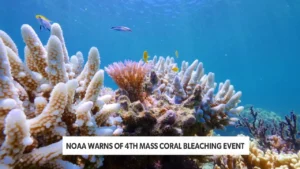
Coral Bleaching
min read
Christina Thompson (Anchor, EarthxNews): A dire warning about the risk of a mass coral bleaching event has marine biologists on high alert!
The US National Oceanic and Atmospheric Administration (NOAA) says the world is on the verge of a fourth mass coral bleaching event, which could see wide swaths of tropical reefs die, including parts of Australia’s Great Barrier Reef. The scientific agency issued the warning after months of record-breaking ocean heat which has some scientists fearing the worst. Derek Manzello, the coordinator of NOAA’s coral reef watch said, “We are literally sitting on the cusp of the worst bleaching event in the history of the planet.”
Scientists say the seasonal El Niño weather pattern, which leads to warmer ocean waters, may be a contributing factor. Researchers say when corals are subjected to heat stress, they expel the colorful algae living in their tissues. Without these helpful algae, the corals become pale and are vulnerable to starvation and disease. Now to merit a global mass bleaching event, a certain percentage of reefs need to reveal a level of heat stress in the ocean basins of the Atlantic, Pacific, and Indian. However, NOAA says they’re still waiting for final confirmation from Indian Ocean scientists to officially raise the flag for the fourth mass bleaching event.
The last global mass coral bleaching event happened from 2014 to 2017. Preliminary results suggest during that timeframe, about 15% of the world’s reefs saw large coral die-offs. The Great Barrier Reef in Australia lost nearly a third of its corals when previous global bleaching events occurred in 2010 and 1998.
While concerns are growing the world could see a fourth mass coral bleaching event, a recent study may offer some hope when it comes to coral restoration. In a new paper, scientists from the University of Exeter, in conjunction with a group of international researchers, revealed planting new coral in degraded reefs can lead to rapid recovery with restored reefs growing as fast as healthy reefs within just 4 years.
Joining us now to discuss is the report’s lead author, Marine Biologist, Coral Reef Ecologist, and Senior Research Fellow at the University of Exeter in the UK, Dr. Ines Lange. Thank you so much for coming on. So this study, it was a collaborative effort between your team and others. Who else was involved, and what did the studies tell you about coral’s resiliency?
Dr. Ines Lange (Marine Biologist & Coral Reef Ecologist): So our team consisted of Indonesian researchers and UK-based researchers from different universities. And we all went out together to Pulau Bontosua, which is a small island off the south — south of the coast of South Sulawesi in Indonesia to study a very successful reef restoration program out there. And to have a look if reef restoration can bring back the important functions of a coral reef.
THOMPSON: So what’s really incredible is, as part of this study, scientists said they were able to successfully restore a 50 meter long section of a reef in Indonesia. Can you tell us about that effort and whether there were any signs of recovery until now?
LANGE: Yeah, so the reef area we saw recovered is like much bigger than that! It’s several hectares already, and we studied smaller sections of the reefs to see the trajectory. So we studied reefs that were restored only a few months ago, a year ago, 2 years ago, 4 years ago — so we really could see the timeline of recovery on these reefs. And it’s incredible to see that, after four years, it’s difficult to distinguish the restoration sites from the healthy reefs nearby. There’s only an occasional glimpse of some steel structure looking out; but, otherwise, it’s as diverse and colorful and full of fish as nearby healthy reef.
THOMPSON: So, NOAA issued a warning that the world could be on the verge of a fourth mass coral bleaching event. Are you concerned that given, um, about this — given the positive results that you were seeing in Indonesia?
LANGE: Of course, I’m very concerned as everyone else. That, like, climate change and bleaching is the major threat to coral reefs worldwide. And the scale of damage that it causes cannot be repaired by reef restoration projects. However, we think that that doesn’t mean we shouldn’t put effort and research into restoration projects because they can have an immense impact locally and on a regional scale. So the reefs that were restored in Indonesia, for example, they have a massive benefit for the local communities. So we shouldn’t not put research into reef restoration just because we don’t think it can help all the reefs around the world.
THOMPSON: One of the reefs restored spelled out the word “hope.” What are your expectations for the future of the world’s coral reefs?
LANGE: That is very hard to say. Unfortunately, despite seeing these glimpses of hope — and I’ve also seen, like, very fast recovery from the last bleaching event — so there is pockets of hope and reefs that are doing better and positive stories to tell. And I think it’s important. But, in general, the situations for reefs worldwide is very dire. And we are seeing more and more mass bleaching events. And if we don’t manage to get temperatures in control and manage our CO2 emissions, then reefs will not have a good chance to survive in a meaningful scale.
THOMPSON: Dr. Ines Lange, thank you for joining us. And thank you for the work that you’re doing with coral reefs.
LANGE: Thank you for having me.
